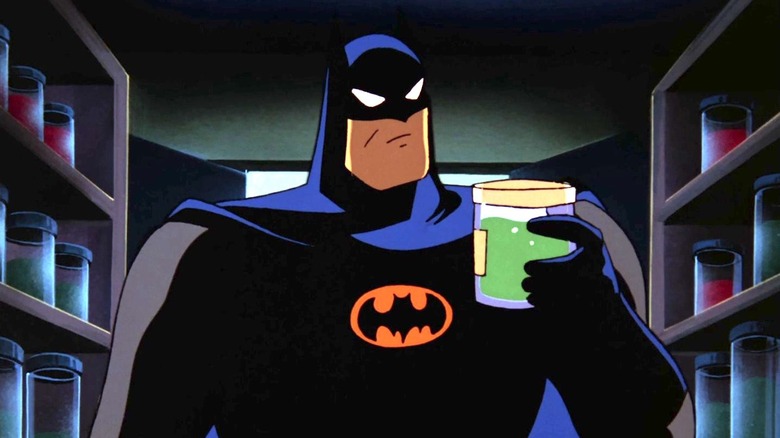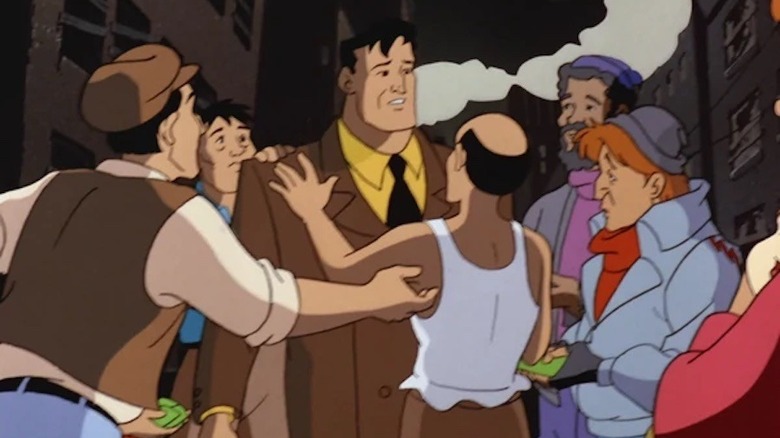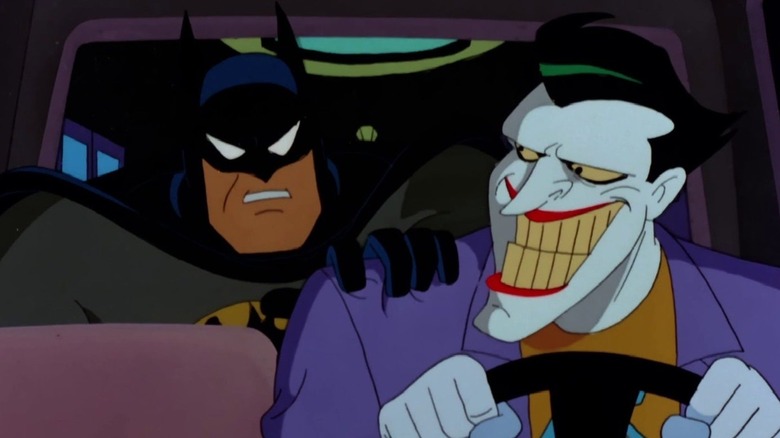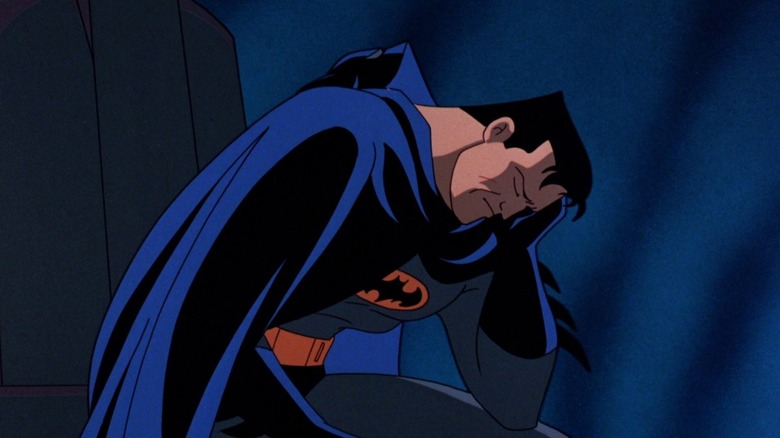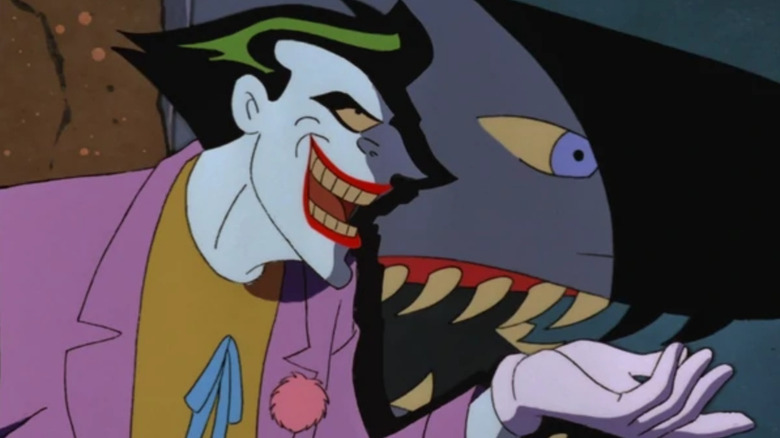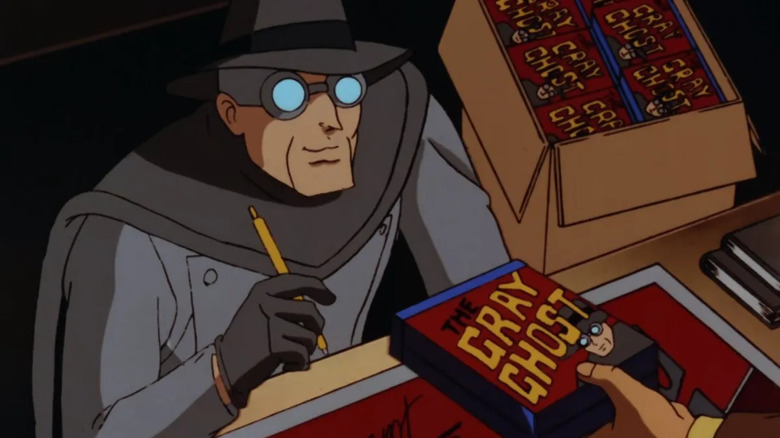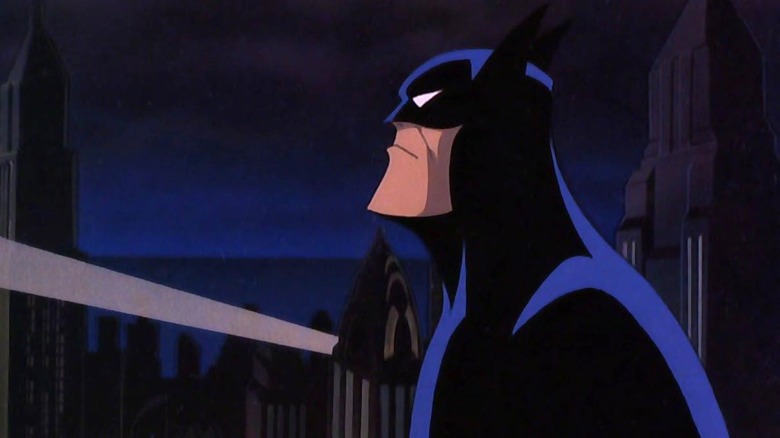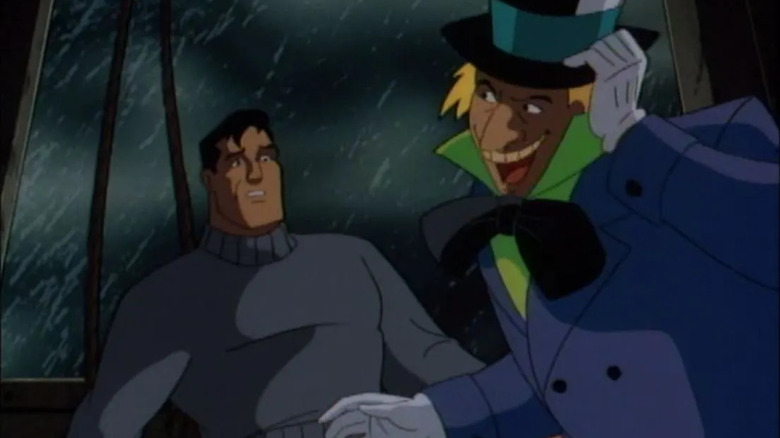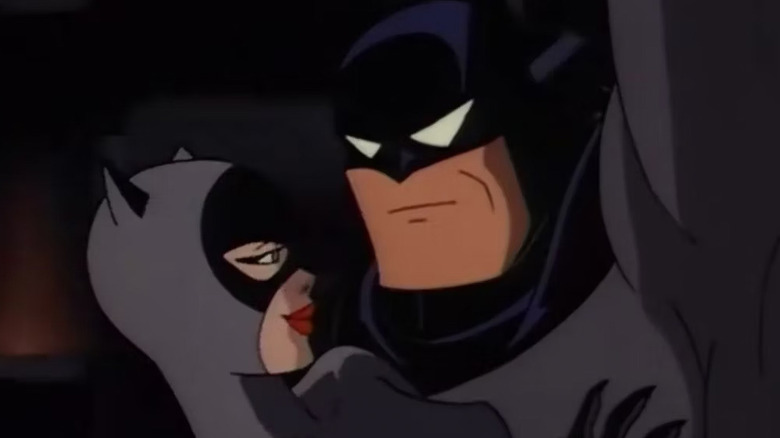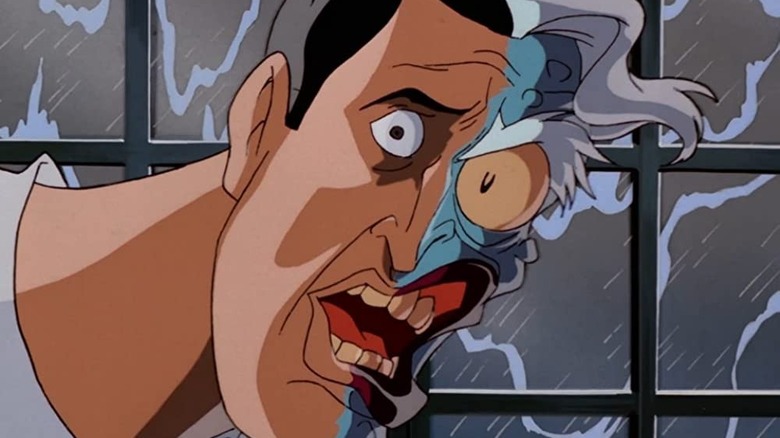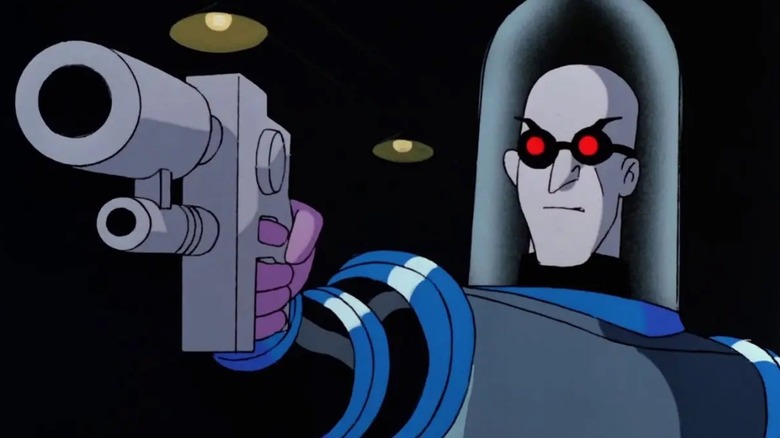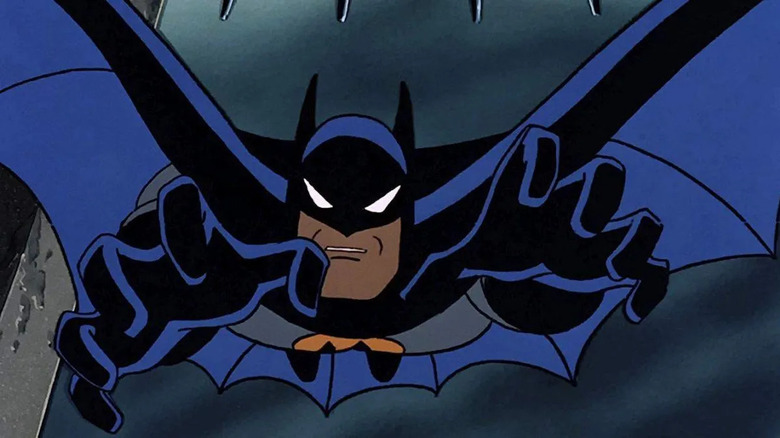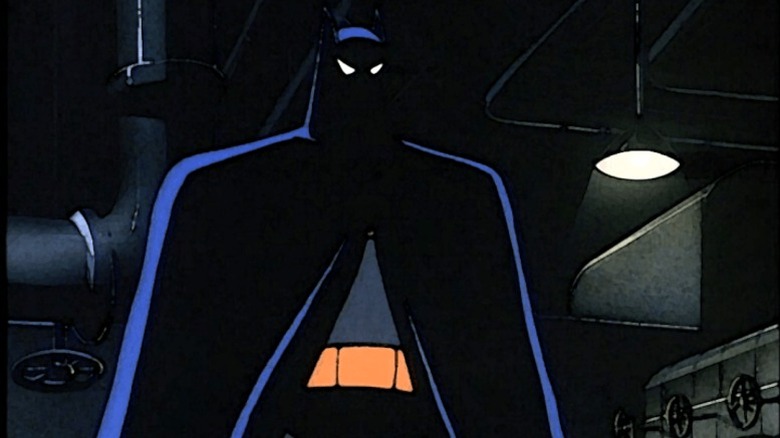Things Only Adults Notice In Batman: The Animated Series
Debuting in 1992, "Batman: The Animated Series" may have been prompted by the success of Tim Burton's "Batman" films, but it has become a seminal animated masterpiece all its own. One of the most beloved kids' cartoons of the era, the series became the cornerstone of an animated universe of shows that included several spin-offs and continuations. Celebrated for its moody atmosphere, high-class animation, and nuanced storytelling, the show's legacy has proved enduring for decades.
When watching as children, we may have delighted in the thrilling escapades of the Dark Knight and the larger-than-life supervillains he confronted each week. But for adults — then and now — there is so much more that can be seen beyond the more superficial comic book excitement that may have eluded younger viewers. And it's those elements that have turned what could have been a simple cartoon into a complex classic.
From the profound themes of redemption and morality to the stellar performances of superstar actors, there is so much going on beneath the surface that kids didn't see. So grab your utility belt, because the Bat-Signal is lit and we're headed out to investigate things that only adults notice in "Batman: The Animated Series."
Batman: The Animated Series explored controversial issues
"Batman: The Animated Series" helped set itself apart from its contemporaries by telling stories with a message. Sure, the likes of "G.I. Joe" and "He-Man" often had moral lessons for kids to learn — and practical life advice as well — but few ever addressed controversial issues with as much nuance or depth as "Batman: The Animated Series." For starters, the show puts a focus on Batman's dislike of firearms, tying it back to the death of his parents that shaped him as a hero, and he often uses it to highlight issues related to crime and gun violence.
But more than just a broad issue that can be felt across the series, several episodes focused almost entirely on social injustice. The episode, "The Forgotten," may not be one of the best episodes of the show, but its attempt to humanize Gotham City's homeless population and put a spotlight on poverty was notable, while "Pretty Poison" used the character of Poison Ivy to discuss environmental activism as a way to give the villain a sympathetic side.
The series wasn't even afraid to address issues of police and government corruption, with episodes that address police misconduct and city officials who abuse their power. "The Sewer King," meanwhile, told the shocking story of a human trafficker that was kidnapping children, while other installments addressed everything from sexism and abuse to wealth inequality and civil rights.
An all-star voice cast
It wasn't just its mature, well-written stories that explored adult themes and serious subject matter that made "Batman: The Animated Series" so unique. With the likes of series creator, Bruce Timm, writers, Paul Dini and Alan Burnett, and so many more behind the scenes, the show stepped up its game across the board, and that included its incredible voice cast. Casting director, Andrea Romano, went above and beyond to find actors that could bring the show to life in ways no other animated afternoon adventure had, and ironically that often meant hiring actors with little to no cartoon experience.
"For a show like 'Batman' I need killer actors," Romano told JoBlo. "Ideally actors with stage credits, because it's that energy that's needed." Kevin Conroy, who became downright legendary as the voice of Batman, had never done animated voice work, in fact, and the casting of big screen Hollywood actors was highly unusual for the time. This included "Star Wars" actor, Mark Hamill, as the Joker, veteran British star, David Warner, as Ra's Al Ghul, composer and singer, Paul Williams, as the Penguin, and highly respected acting royalty like Efrem Zimbalist Jr. and Bob Hastings as Alfred and Commissioner Gordon.
Kids may not have recognized any of the famous names behind the mic or understood the gravitas they brought to the series, yet thanks to their enormous talent, they provided a quality of work that even young fans recognized made it different from everything else on the dial.
Stories that explored the psyche of a hero
Serious social issues weren't the only things that were explored with subtly and grace in "Batman: The Animated Series." By contrast to typical comic book superhero fare in the '80s — where the likes of "Spider-Man and His Amazing Friends" and "Teenage Mutant Ninja Turtles" focused more on the light-hearted, bombastic adventures and often comical crime-stopping antics, "Batman: The Animated Series" put almost as much of its attention on the internal psychological battles fought by its hero.
Nowhere is this more acutely observed than in the episode, "I Am The Night," where Batman faces an existential dilemma when he fears that his role as a crime fighter is all for nothing after his friend, Commissioner Gordon, is struck down and near death. Mourning his friend, Batman begins to spiral into an emotional crisis as he wonders what the point of being Batman is if he can't protect those closest to him. "Perchance to Dream," meanwhile, may be a fanciful story where the Mad Hatter traps Batman in an imaginary world, but it's also a thoughtful, introspective story that sees Batman facing up to his role as the Dark Knight, and how he's sacrificed his own happiness to save lives.
Did kids watching fully grasp what these stories were trying to say about the duality of man and the nature of being a hero? Maybe not exactly, but they probably understood that something important and meaningful was being explored, and it was about a lot more than costumed heroes fighting off colorful supervillains.
Episodes that were based on classic comic books
Batman has been adventuring in comics since 1939, when he made his debut in "Detective Comics" #27, so by the time "Batman: The Animated Series" began airing in 1992, he'd amassed more than 50 years of comic book stories. The writers of the series didn't just take loose inspiration from those published tales, though, and actually adapted quite a few of them directly for the screen. And because some of them had seen print decades before, it's likely kids had no idea that the stories they were watching were originally written so long ago.
"The Laughing Fish," one of the first episodes to air, was based on a story told across "Detective Comics" #475 and #476 from 1978, by Steve Englehart and Marshall Rogers. It's not just stories involving Batman's biggest villains, though, but smaller, quieter stories, too, including the crime thriller, "A Bullet for Bullock," which sees Gotham's resident tough cop the target of a mysterious assassin, based on a more recent story of the same name from "Detective Comics" #651.
"The Cape and the Cowl Conspiracy," an episode about a villain named Wormwood who attempts to steal Batman's costume, was based on "The Cape & Cowl Deathtrap" from 1975, while the episode, "Moon of the Wolf," was originally from in"Batman" #255 in 1974. from Len Wein and Neal Adams. Kids may have just seen some fun adventures, but longtime Batman fans got the added treat of seeing some classic stories adapted for the screen.
An homage to a previous Batman
Being based on one of the most famous comic books in the history of the medium, it makes sense that "Batman: The Animated Series" would see plenty of homages to stories from the hero's past. But in one installment titled "Beware the Gray Ghost," the series paid tribute not to a classic comic book story, but to another TV adaptation of the Caped Crusader, and it did in a subtle way that many kids may have missed at the time.
In a meta-story, "Beware the Gray Ghost" sees Gotham terrorized by a villain calling himself the Mad Bomber. Batman recognizes the madman's scheme as identical to an episode of a superhero TV show from his youth: "The Gray Ghost." To get to the bottom of the case, Batman seeks out Simon Trent, the washed-up actor who had played the hero on TV, who in his older years, has struggled to get work. After clearing Trent of suspicion that he could be the bomber, Batman finds himself working alongside his childhood idol to take down the terrorist.
While the episode is a good one on its own merits, it's made all the better by casting Adam West — the star of the 1966 live-action "Batman" TV series — as Trent. Kids may not have recognized him, but the aging West, slipping into the role of a retired superhero actor, was a sly nod to the past that every adult watching surely enjoyed.
The influence of film noir
Today, children have more access to older movies and discussion of film history than ever before thanks to services like Netflix and YouTube. Some young teens and even kids may have knowledge of older movies and the influence they've had on modern movies, but in 1992, it probably went over the heads of kids in the audience when "Batman: The Animated Series" took direct cues from classic American cinema. All kids knew was that this new series was darker and more dramatic than other shows, but they probably didn't know how much of the look and feel of the series was inspired by film noir.
A genre that is well-recognized today thanks to a surge in popularity with films like "John Wick," film noir is categorized by its stark use of color, hard-boiled crime fiction stories, and a moody atmosphere, often characterized by a central hero dealing with an internal struggle while battling an outward enemy. Classics like "The Maltese Falcon," "Double Indemnity," and "A Touch of Evil" by renowned directors John Huston, Billy Wilder, and Orson Welles all leave their mark on "Batman: The Animated Series," which owes a great deal to the genre's distinct visuals and recognizable storytelling hallmarks.
Providing the Dark Knight with a new look for the 1990s, the series looked backward, and it's the show's influence from 1940s film noir that has ironically helped it remain as timeless as ever more than 30 years later.
Bruce Wayne is Batman's disguise
Some of the best superheroes wear a mask to conceal their true identity, whether it's Spider-Man, Iron Man, or the Flash. But for Batman, it's the other way around: his persona as an avenging crusader stands in contrast to the affable, almost jovial Bruce Wayne, but it's the grim, sinister force of justice that is his true self, while his playboy persona of Bruce Wayne is the mask he wears to conceal his identity from the world. And nowhere is this more apparent than in "Batman: The Animated Series."
In the show, not only does voice actor Kevin Conroy speak in two separate voices as Batman and Bruce, but even when he's out of his Batman costume — when Bruce is alone, or in the company of his closest confidantes like Alfred or Robin — he still speaks in Batman's more low-pitched, gravelly voice. This tells the audience that Batman is the real person, while Wayne is the disguise.
Conroy's clever acting choice is a subtle aspect of the character that is easy to miss if you aren't looking for it, but it's unmistakable once you spot it. And it's likely that kids didn't notice, but the adults in the audience — particularly those familiar with the character from the comics — almost certainly spotted that little detail.
Sexual tension and suggestive innuendo
Written with youngsters in mind, "Batman: The Animated Series" featured stories about inner city crime, with crooks wielding real guns — not laser weapons like on "G.I. Joe" — with episodes about drug addiction and child abuse. Yet, it is still sometimes surprising to notice just how much sexual innuendo pops up in the series, with suggestive imagery and bits of dialogue that would make even some adults blush. It was done cleverly enough that it likely went over the heads of the kids in the audience but when Catwoman runs a fever and Batman feels her head and says she's hot, it's hard for adults not to chuckle at her flirtatious response, "now you notice."
Likewise, the relationship between Harley Quinn and the Joker is suggested more than once to be a lot more than a criminal kingpin and his colorful lackey, with the clear implication that they're also involved sexually and romantically. When she asks "Mr. J" if he wants to "rev his Harley" in the episode, "Mad Love," it even pushes the boundaries of appropriateness.
Similarly, the episode, "Harley & Ivy," where Poison Ivy and Harley Quinn become partners in crime, is packed with double entendres and risque commentary that in hindsight can seem out of place in a kids' show. The episode also highlights the pair's incredibly toxic, manipulative, and downright abusive sexual relationship, something that only the adults probably picked up on.
Stories about mental illness
In the comics, many of Batman's rogues gallery had been more often portrayed as deranged, psychotic madmen. Adapted into "Batman: The Animated Series," it wouldn't have been all that surprising if they were portrayed as just that, because that's typically how most children's shows depicted their villains. But the series does something different, turning many of Batman's worst enemies into sympathetic villains; Instead of being simply evil, they are troubled souls who faced trauma and mental illness that they struggled to contain.
This includes Arnold Wesker, a ventriloquist who suffers from schizophrenia due to a traumatic childhood that results in the creation of Scarface, a separate personality that is embodied by a wooden dummy that becomes a criminal mastermind. But nowhere is the subject of trauma and mental illness more apparent than in the origin of Two-Face, former District Attorney Harvey Dent, who is shown to be seeing a psychiatrist for his own personality problems that are the result of childhood trauma.
It's certainly open for debate whether the show handled the subject with the right amount of sensitivity, but kids probably didn't even notice it. For adults watching, however, it's hard to miss the emphasis on the villain's own psychological issues and discussion of mental illness.
If you or someone you know needs help with mental health, please contact the Crisis Text Line by texting HOME to 741741, call the National Alliance on Mental Illness helpline at 1-800-950-NAMI (6264), or visit the National Institute of Mental Health website.
Serialized storytelling
These days it's the norm for TV shows to carry stories from episode to episode, with many shows telling a single tale across an entire season. Even in shows with episodic adventures, subplots, and character arcs span the entire series, but that definitely wasn't the case for TV in the '80s and early '90s, especially among kids' cartoons. In an era before streaming particularly, shows were designed to allow children to watch any episode in any order, and were almost entirely standalone in nature, with the events of previous episodes rarely mentioned to avoid confusing younger audiences who may not have seen them. But "Batman: The Animated Series" changed all that.
From the very first episode, where Robert Langstrom is turned into the villain, Man-Bat, the series plants the seeds for future ongoing, serialized stories. Langstrom would not only return in a future episode but his first appearance and the events of that episode are heavily referenced as an important part of the story. So too was the tale of Mr. Freeze, who was desperate to save the life of his dying wife in his first appearance, which continues to play a crucial role in multiple episodes.
Perhaps most important, though, is the story of Harvey Dent. First introduced in the pilot episode as Gotham's District Attorney and friend of Bruce Wayne, kids may not have realized that the show was laying the groundwork for his later transformation into the villainous Two-Face.
It's all about redemption
Between the exploration of social issues and stories about mental illness, "Batman: The Animated Series" delved into some seriously dramatic subject matter, and may still be one of the smartest cartoons ever aimed at a young audience. Whether the kids watching understood it all doesn't matter, because they absorbed it and learned its lessons, and one of the most powerful that they might not have picked up on was its theme of redemption. Because, unlike so many superhero stories that came before, "Batman: The Animated Series" showed that even the worst of us can be deserving of a second chance.
Thanks to the portrayal of villains as suffering souls rather than psychotic lunatics, the series shows that we can all seek salvation and find forgiveness. Redemption can come in many forms, and throughout the series, we see several of the worst villains nearly finding it, and Batman himself working to help even his biggest enemies turn over a new leaf. This includes Harvey Dent, who Batman tries to help reform after becoming Two-Face, and even Clayface, who he seems genuinely sympathetic to, even promising him to help find a cure for his condition.
This theme of redemption continued in "Harley's Holiday" — where as both Batman and Bruce Wayne — the hero desperately tries to help Joker's former henchwoman start a new life. Redemption is also the focus of the "New Batman Adventures" episode, "Old Wounds," where we see Batman has actually been successful in helping a criminal put his past behind him.
The show's impact on kids' television
Looking at the many elements that only adults noticed in "Batman: The Animated Series," it becomes clear just how different and groundbreaking the series was, shaking up the status quo of kids' cartoons. The show's more realistic depiction of crime and violence, its sympathetic villains, ongoing storytelling, and more, the series was such a radical departure from what kids were used to on weekday afternoons when the most popular shows were the likes of "Animaniacs," "Darkwing Duck," and "Teenage Mutant Ninja Turtles." But what even the adults may not have seen coming is just how influential the series would be, helping to reshape the landscape of kids' cartoons.
The most famous example would have to be Disney's "Gargoyles," a dark, gothic superhero adventure set in New York City which also addressed real-world social issues like racism and gun violence. "I'm a HUGE fan of 'Batman: the Animated Series,'" said "Gargoyles" creator Greg Weisman 2016. Weisman insisted that while they weren't trying to copy the Dark Knight series, he did acknowledge that its existence gave Disney "the courage to put 'Gargoyles' on the air."
"Gargoyles" wasn't the only one. Rival comic publisher Marvel soon launched similar shows of their own, with the now-iconic "Spider-Man: The Animated Series" and "X-Men" cartoons launching not long after "Batman." Both shows featured serious, dramatic stories, and serialized adventures, proving that kids craved mature themes and smart writing where "Batman" had paved the way.
